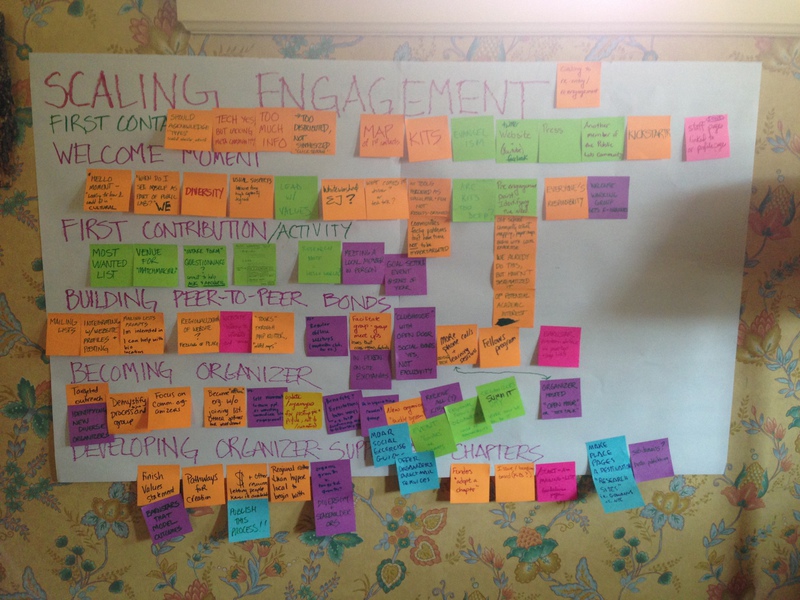
Strategic Plan for Community Development
This is a revision from October 22, 2014 18:23.
View all revisions
Iterations:
October 2014
April 2014
Engagement model
- First Contact
- Welcome moment
- First contribution
- Building peer-to-peer bonds
- Becoming an organizer / being an organizer
- Chapters
- Circle back
First contact
- trace how folks first find encounter Public Lab and get drawn in: http://publiclab.org/wiki/first-encounters
- kits (online store, physical packaging, object without packaging), web presence, social media, press coverage, heard about from a person (evangelism?), Kickstarter campaign, ...
- ISSUE: website front page
- too much information, lacks community presence/identity, not synthesized
Welcome moment
- Looking for how I "fit in"
- lead with values
- culturally, is the first "welcome" over dinner or by typing into a technical discussion?
- identifying the "need" to engage -- begin with what is already known locally -- asset mapping exercise -- needs to be systematized. This can combat the perception problem of tools seen as speculative not results-oriented.
- attracting diversity in the context that many current active members have leisure time, are high capacity with degrees.
- whose responsibility is it to welcome / orient new members who ask?
- everyone / no one?
- Welcome Working Group: good, but has scaling issues
- option to speak to types of stakeholders:
- reference from Sugar Labs,
- and Scott's metaphor below:
First contribution / activity
- "When do I see myself as a part of Public Lab?"
- Hello Moment
- publiclab.org/signup --> profile page
- joining a mailing list
- going to an event / meeting someone in person
- posting a research note
- NEW: Ask a question / answer a question forums
- serves as a venue for matchmaking
- develops a Most Wanted List to prioritize R&D
Forming peer-to-peer bonds
- mailing list discussions
- prompts upon joining to say "I am interested in [...], I can help with [...], bio, location
- comments on research notes
- website:
- further integration of lists and website (future)
- regionalization of website / feeling of place
- listening to interests and areas
- tours of places through mapknitter
- collaborative editing on wikis / pads**
- regularly scheduled meetups
- not just tech, but also goal setting, asset mapping, strategizing, learning
- on research sites
- cross-group and cross-region exchanges
- voice channels: openhour
- ISSUE: social bonds should not result in clubhouse effect
Becoming an organizer
- update / demystify nomination process:
- change nomination process to focus on profile pages
- self-nomination for folks instantly seeking a higher level of engagement
- options for community organizers who may be offline / won't join email list
- attracting new organizers:
- targeting outreach, diversity
Being an organizer:
- resources for organizers
- buddy system with experienced organizer
- event "guides"
- receive all foldable kits
- direct mail service for distributing kits / GMFs within their region
- speaking opportunities on OpenHour
- Organizers Summit (day before annual Barnraising)
- benefits / expectations
- regional focus to nurture new members, partner orgs, and research sites
- staying engaged monthly
- annual survey for re-up
- fundraising support
- Fellows Program
Developing organizer-supported chapters
- review and publish pathway for chapter creation
- have regional organizer in place
- guidelines for joining a regional list before starting a new hyperlocal mailing-list
- Place pages:
- highlight research site(s)
- subdomains like boston.publiclab.org
- featuring partner organizations
- resources for chapters
- organizers can apply for resources for local events
- funders can "Adopt a Chapter"
- ISSUE: organic growth vs targeted growth?
Circle back
- barnstars model outcomes
- finish and review Values statement
Priorities for depth:
- develop better structure to become and contribute as an organizer
- Organizer Summit
- distributing resources
- include social process throughout online and offline
- community asset mapping workshops, dialogue education facilitation, modes of communication beyond email groups, OpenHour, guides and distance learning, offline logbooks, etc
- make a strong translation model for our "communities of practice", see below:
Priorities for growth
- improve first contact experience
- integrate with Kits Initiative
